Exploring Principles of Person-Centered Care in Healthcare Settings
VerifiedAdded on 2023/01/23
|8
|2309
|83
Essay
AI Summary
This essay delves into the principles of Person-Centered Care (PCC), a healthcare approach prioritizing the patient's needs and values. It examines four key principles: autonomy, valuing people, good communication, and family involvement. The essay explores how nurses can apply these principles to enhance patient safety and the quality of care. It emphasizes the importance of respecting patient choices, treating patients with dignity, fostering effective communication, and involving families in the care process. The essay highlights how nurses, as intermediaries, can collaborate with patients and other healthcare professionals to create individualized care plans and improve patient outcomes. The discussion is supported by scholarly references, emphasizing the significance of education, training, and interprofessional collaboration in implementing PCC effectively.
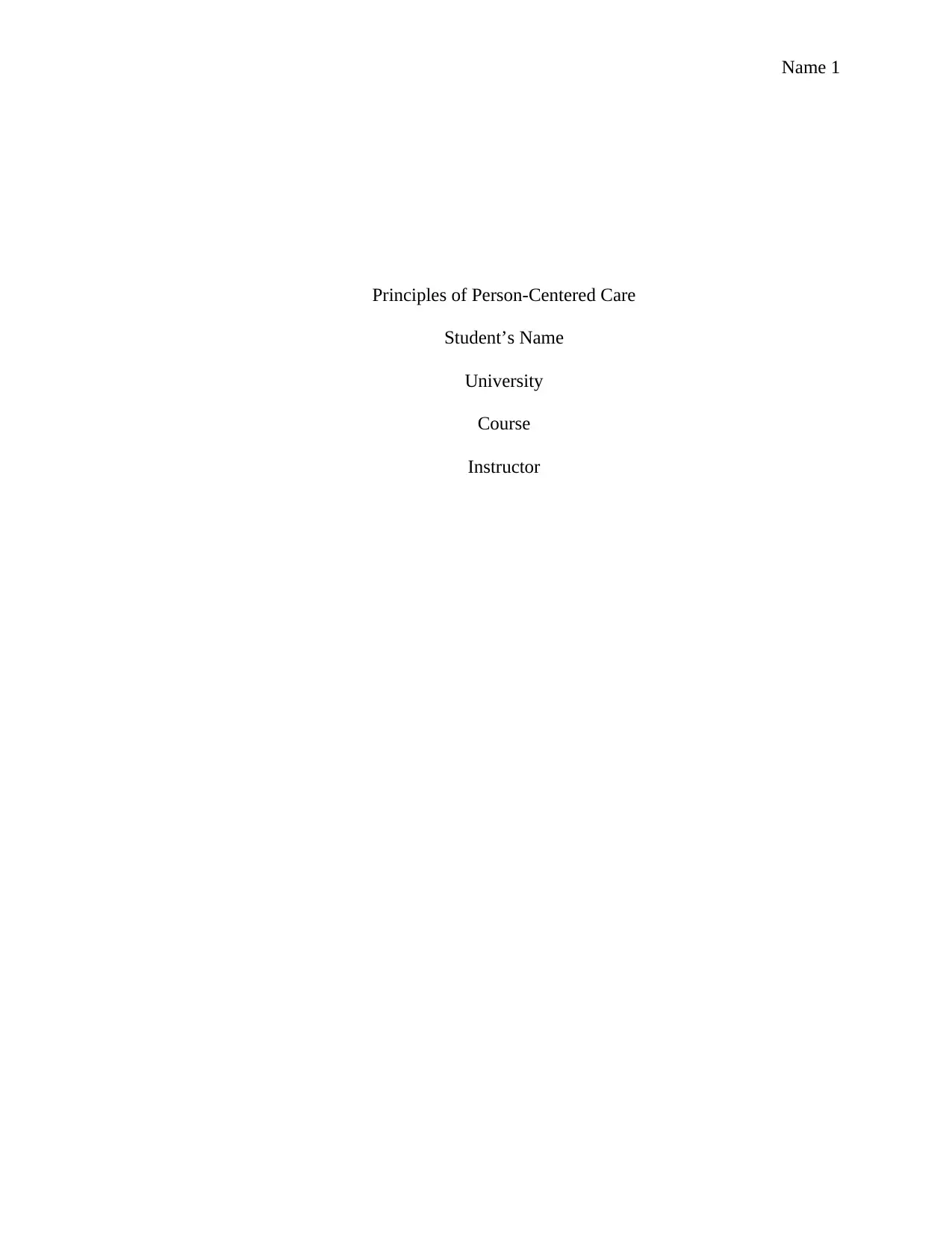
Name 1
Principles of Person-Centered Care
Student’s Name
University
Course
Instructor
Principles of Person-Centered Care
Student’s Name
University
Course
Instructor
Paraphrase This Document
Need a fresh take? Get an instant paraphrase of this document with our AI Paraphraser
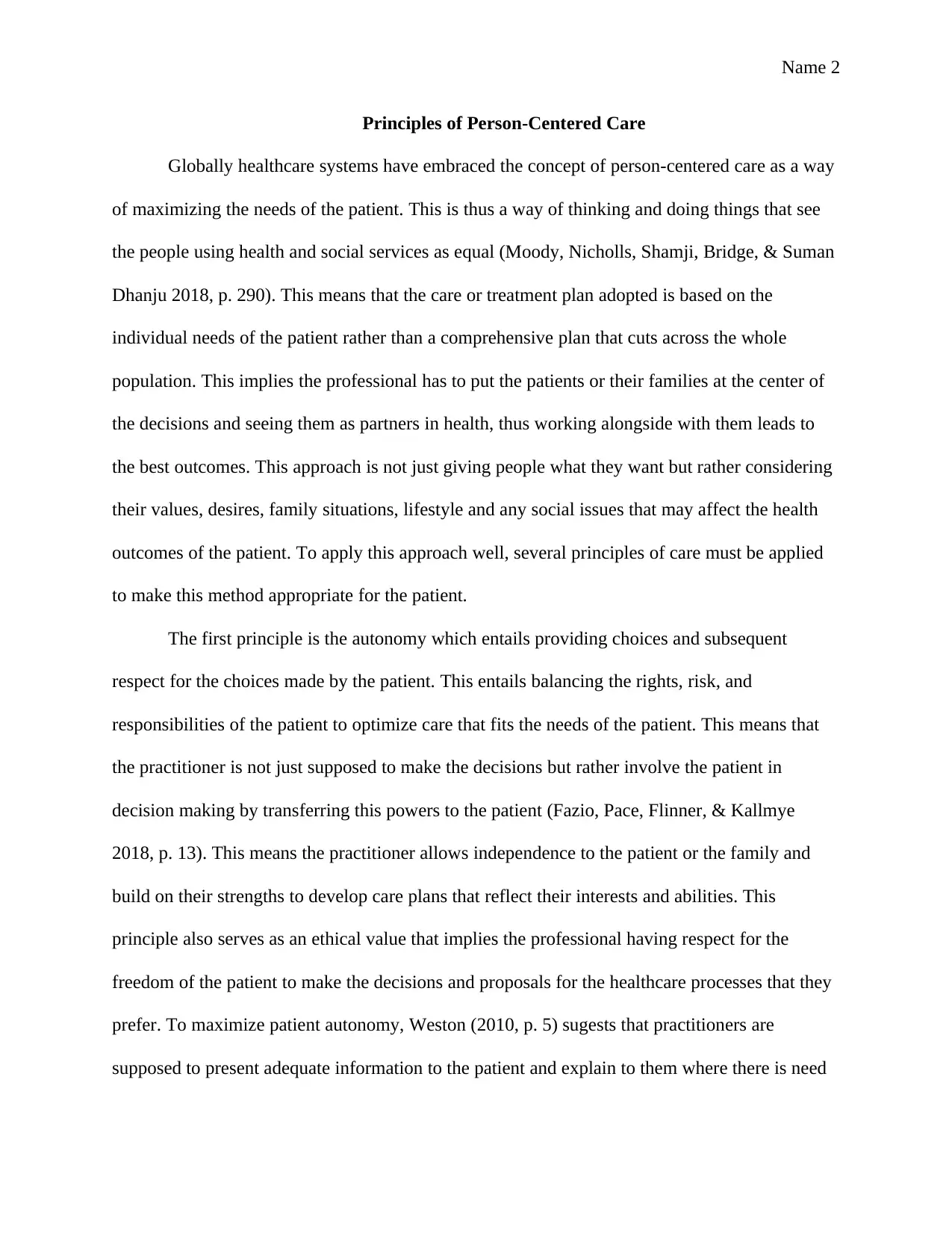
Name 2
Principles of Person-Centered Care
Globally healthcare systems have embraced the concept of person-centered care as a way
of maximizing the needs of the patient. This is thus a way of thinking and doing things that see
the people using health and social services as equal (Moody, Nicholls, Shamji, Bridge, & Suman
Dhanju 2018, p. 290). This means that the care or treatment plan adopted is based on the
individual needs of the patient rather than a comprehensive plan that cuts across the whole
population. This implies the professional has to put the patients or their families at the center of
the decisions and seeing them as partners in health, thus working alongside with them leads to
the best outcomes. This approach is not just giving people what they want but rather considering
their values, desires, family situations, lifestyle and any social issues that may affect the health
outcomes of the patient. To apply this approach well, several principles of care must be applied
to make this method appropriate for the patient.
The first principle is the autonomy which entails providing choices and subsequent
respect for the choices made by the patient. This entails balancing the rights, risk, and
responsibilities of the patient to optimize care that fits the needs of the patient. This means that
the practitioner is not just supposed to make the decisions but rather involve the patient in
decision making by transferring this powers to the patient (Fazio, Pace, Flinner, & Kallmye
2018, p. 13). This means the practitioner allows independence to the patient or the family and
build on their strengths to develop care plans that reflect their interests and abilities. This
principle also serves as an ethical value that implies the professional having respect for the
freedom of the patient to make the decisions and proposals for the healthcare processes that they
prefer. To maximize patient autonomy, Weston (2010, p. 5) sugests that practitioners are
supposed to present adequate information to the patient and explain to them where there is need
Principles of Person-Centered Care
Globally healthcare systems have embraced the concept of person-centered care as a way
of maximizing the needs of the patient. This is thus a way of thinking and doing things that see
the people using health and social services as equal (Moody, Nicholls, Shamji, Bridge, & Suman
Dhanju 2018, p. 290). This means that the care or treatment plan adopted is based on the
individual needs of the patient rather than a comprehensive plan that cuts across the whole
population. This implies the professional has to put the patients or their families at the center of
the decisions and seeing them as partners in health, thus working alongside with them leads to
the best outcomes. This approach is not just giving people what they want but rather considering
their values, desires, family situations, lifestyle and any social issues that may affect the health
outcomes of the patient. To apply this approach well, several principles of care must be applied
to make this method appropriate for the patient.
The first principle is the autonomy which entails providing choices and subsequent
respect for the choices made by the patient. This entails balancing the rights, risk, and
responsibilities of the patient to optimize care that fits the needs of the patient. This means that
the practitioner is not just supposed to make the decisions but rather involve the patient in
decision making by transferring this powers to the patient (Fazio, Pace, Flinner, & Kallmye
2018, p. 13). This means the practitioner allows independence to the patient or the family and
build on their strengths to develop care plans that reflect their interests and abilities. This
principle also serves as an ethical value that implies the professional having respect for the
freedom of the patient to make the decisions and proposals for the healthcare processes that they
prefer. To maximize patient autonomy, Weston (2010, p. 5) sugests that practitioners are
supposed to present adequate information to the patient and explain to them where there is need
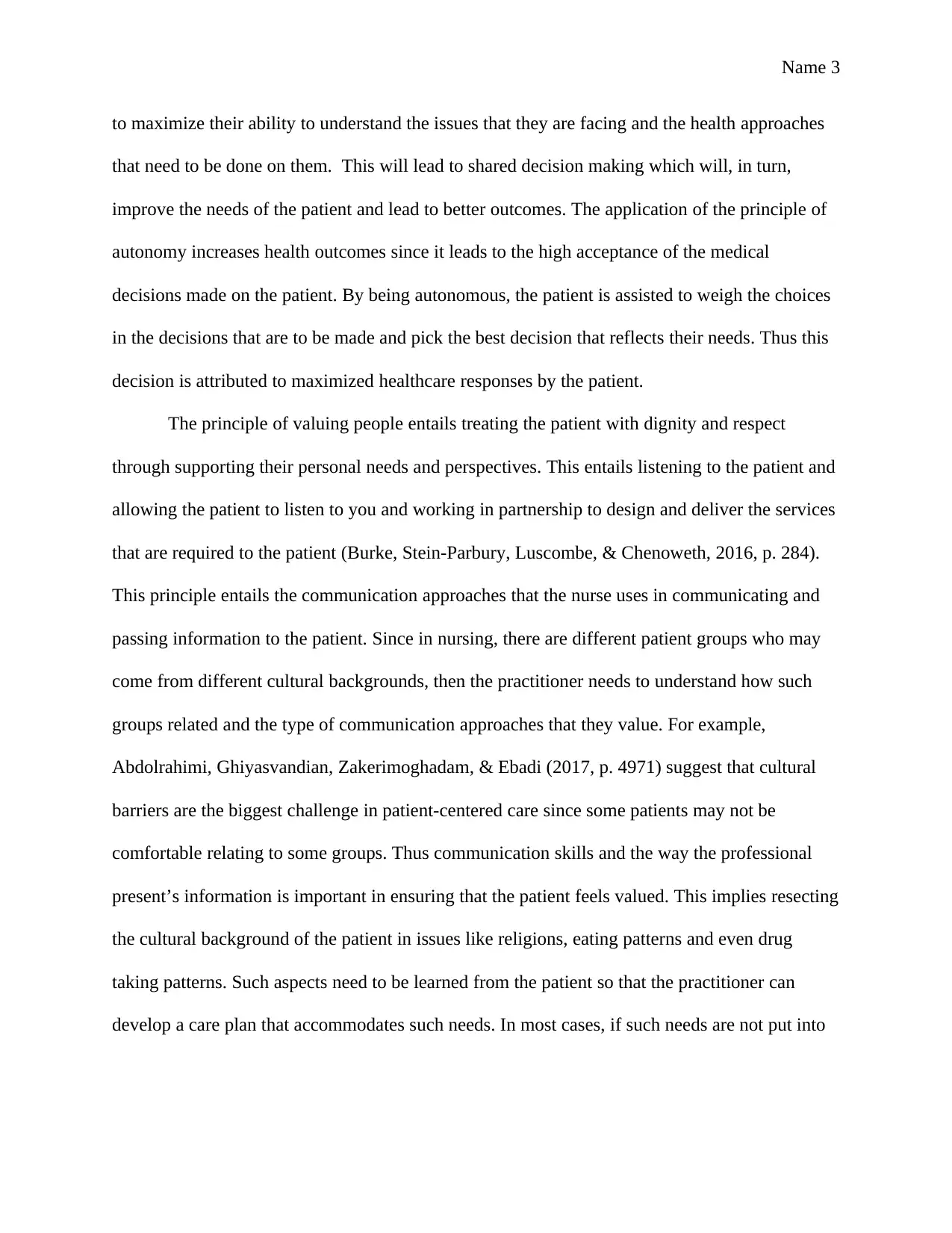
Name 3
to maximize their ability to understand the issues that they are facing and the health approaches
that need to be done on them. This will lead to shared decision making which will, in turn,
improve the needs of the patient and lead to better outcomes. The application of the principle of
autonomy increases health outcomes since it leads to the high acceptance of the medical
decisions made on the patient. By being autonomous, the patient is assisted to weigh the choices
in the decisions that are to be made and pick the best decision that reflects their needs. Thus this
decision is attributed to maximized healthcare responses by the patient.
The principle of valuing people entails treating the patient with dignity and respect
through supporting their personal needs and perspectives. This entails listening to the patient and
allowing the patient to listen to you and working in partnership to design and deliver the services
that are required to the patient (Burke, Stein-Parbury, Luscombe, & Chenoweth, 2016, p. 284).
This principle entails the communication approaches that the nurse uses in communicating and
passing information to the patient. Since in nursing, there are different patient groups who may
come from different cultural backgrounds, then the practitioner needs to understand how such
groups related and the type of communication approaches that they value. For example,
Abdolrahimi, Ghiyasvandian, Zakerimoghadam, & Ebadi (2017, p. 4971) suggest that cultural
barriers are the biggest challenge in patient-centered care since some patients may not be
comfortable relating to some groups. Thus communication skills and the way the professional
present’s information is important in ensuring that the patient feels valued. This implies resecting
the cultural background of the patient in issues like religions, eating patterns and even drug
taking patterns. Such aspects need to be learned from the patient so that the practitioner can
develop a care plan that accommodates such needs. In most cases, if such needs are not put into
to maximize their ability to understand the issues that they are facing and the health approaches
that need to be done on them. This will lead to shared decision making which will, in turn,
improve the needs of the patient and lead to better outcomes. The application of the principle of
autonomy increases health outcomes since it leads to the high acceptance of the medical
decisions made on the patient. By being autonomous, the patient is assisted to weigh the choices
in the decisions that are to be made and pick the best decision that reflects their needs. Thus this
decision is attributed to maximized healthcare responses by the patient.
The principle of valuing people entails treating the patient with dignity and respect
through supporting their personal needs and perspectives. This entails listening to the patient and
allowing the patient to listen to you and working in partnership to design and deliver the services
that are required to the patient (Burke, Stein-Parbury, Luscombe, & Chenoweth, 2016, p. 284).
This principle entails the communication approaches that the nurse uses in communicating and
passing information to the patient. Since in nursing, there are different patient groups who may
come from different cultural backgrounds, then the practitioner needs to understand how such
groups related and the type of communication approaches that they value. For example,
Abdolrahimi, Ghiyasvandian, Zakerimoghadam, & Ebadi (2017, p. 4971) suggest that cultural
barriers are the biggest challenge in patient-centered care since some patients may not be
comfortable relating to some groups. Thus communication skills and the way the professional
present’s information is important in ensuring that the patient feels valued. This implies resecting
the cultural background of the patient in issues like religions, eating patterns and even drug
taking patterns. Such aspects need to be learned from the patient so that the practitioner can
develop a care plan that accommodates such needs. In most cases, if such needs are not put into
⊘ This is a preview!⊘
Do you want full access?
Subscribe today to unlock all pages.

Trusted by 1+ million students worldwide
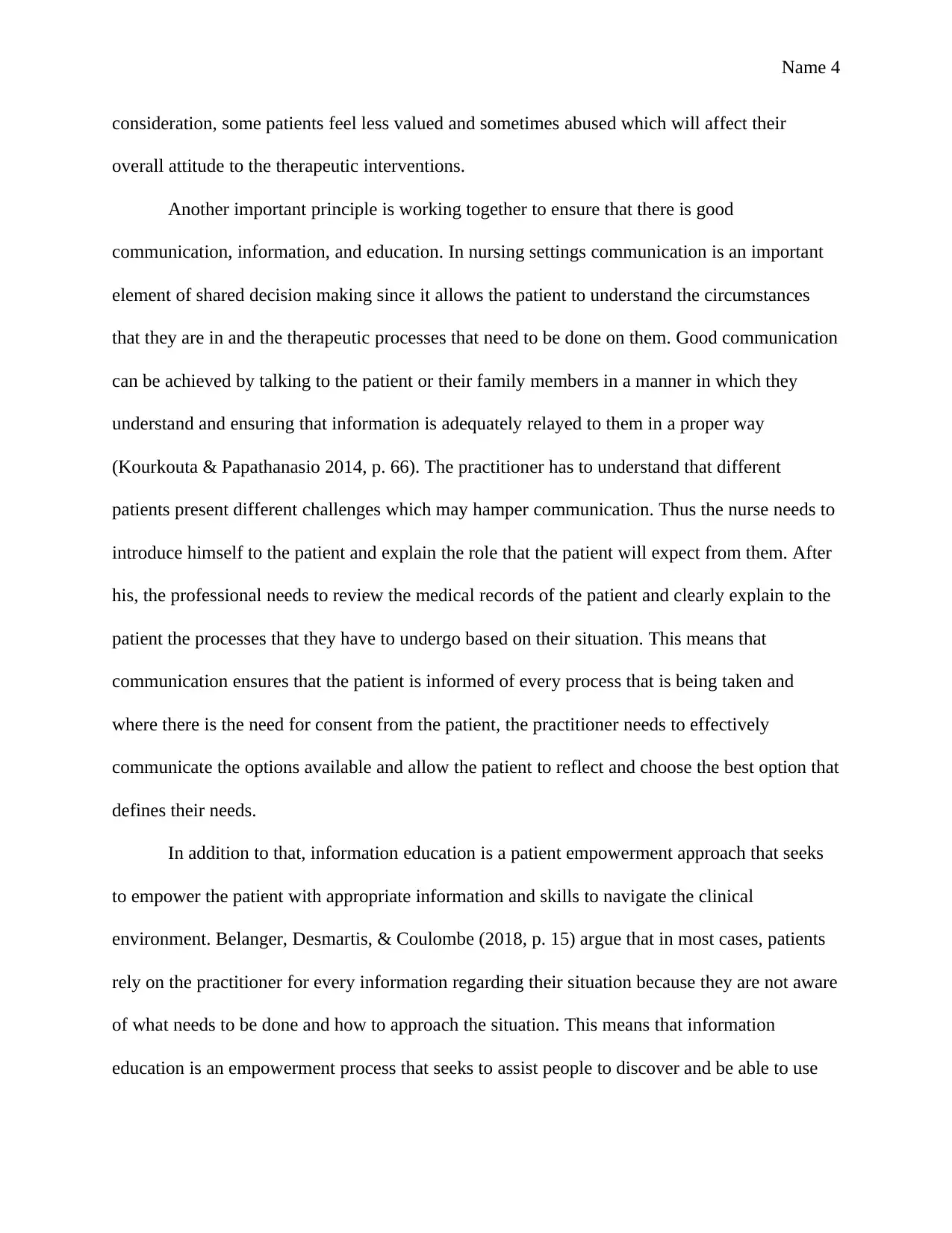
Name 4
consideration, some patients feel less valued and sometimes abused which will affect their
overall attitude to the therapeutic interventions.
Another important principle is working together to ensure that there is good
communication, information, and education. In nursing settings communication is an important
element of shared decision making since it allows the patient to understand the circumstances
that they are in and the therapeutic processes that need to be done on them. Good communication
can be achieved by talking to the patient or their family members in a manner in which they
understand and ensuring that information is adequately relayed to them in a proper way
(Kourkouta & Papathanasio 2014, p. 66). The practitioner has to understand that different
patients present different challenges which may hamper communication. Thus the nurse needs to
introduce himself to the patient and explain the role that the patient will expect from them. After
his, the professional needs to review the medical records of the patient and clearly explain to the
patient the processes that they have to undergo based on their situation. This means that
communication ensures that the patient is informed of every process that is being taken and
where there is the need for consent from the patient, the practitioner needs to effectively
communicate the options available and allow the patient to reflect and choose the best option that
defines their needs.
In addition to that, information education is a patient empowerment approach that seeks
to empower the patient with appropriate information and skills to navigate the clinical
environment. Belanger, Desmartis, & Coulombe (2018, p. 15) argue that in most cases, patients
rely on the practitioner for every information regarding their situation because they are not aware
of what needs to be done and how to approach the situation. This means that information
education is an empowerment process that seeks to assist people to discover and be able to use
consideration, some patients feel less valued and sometimes abused which will affect their
overall attitude to the therapeutic interventions.
Another important principle is working together to ensure that there is good
communication, information, and education. In nursing settings communication is an important
element of shared decision making since it allows the patient to understand the circumstances
that they are in and the therapeutic processes that need to be done on them. Good communication
can be achieved by talking to the patient or their family members in a manner in which they
understand and ensuring that information is adequately relayed to them in a proper way
(Kourkouta & Papathanasio 2014, p. 66). The practitioner has to understand that different
patients present different challenges which may hamper communication. Thus the nurse needs to
introduce himself to the patient and explain the role that the patient will expect from them. After
his, the professional needs to review the medical records of the patient and clearly explain to the
patient the processes that they have to undergo based on their situation. This means that
communication ensures that the patient is informed of every process that is being taken and
where there is the need for consent from the patient, the practitioner needs to effectively
communicate the options available and allow the patient to reflect and choose the best option that
defines their needs.
In addition to that, information education is a patient empowerment approach that seeks
to empower the patient with appropriate information and skills to navigate the clinical
environment. Belanger, Desmartis, & Coulombe (2018, p. 15) argue that in most cases, patients
rely on the practitioner for every information regarding their situation because they are not aware
of what needs to be done and how to approach the situation. This means that information
education is an empowerment process that seeks to assist people to discover and be able to use
Paraphrase This Document
Need a fresh take? Get an instant paraphrase of this document with our AI Paraphraser
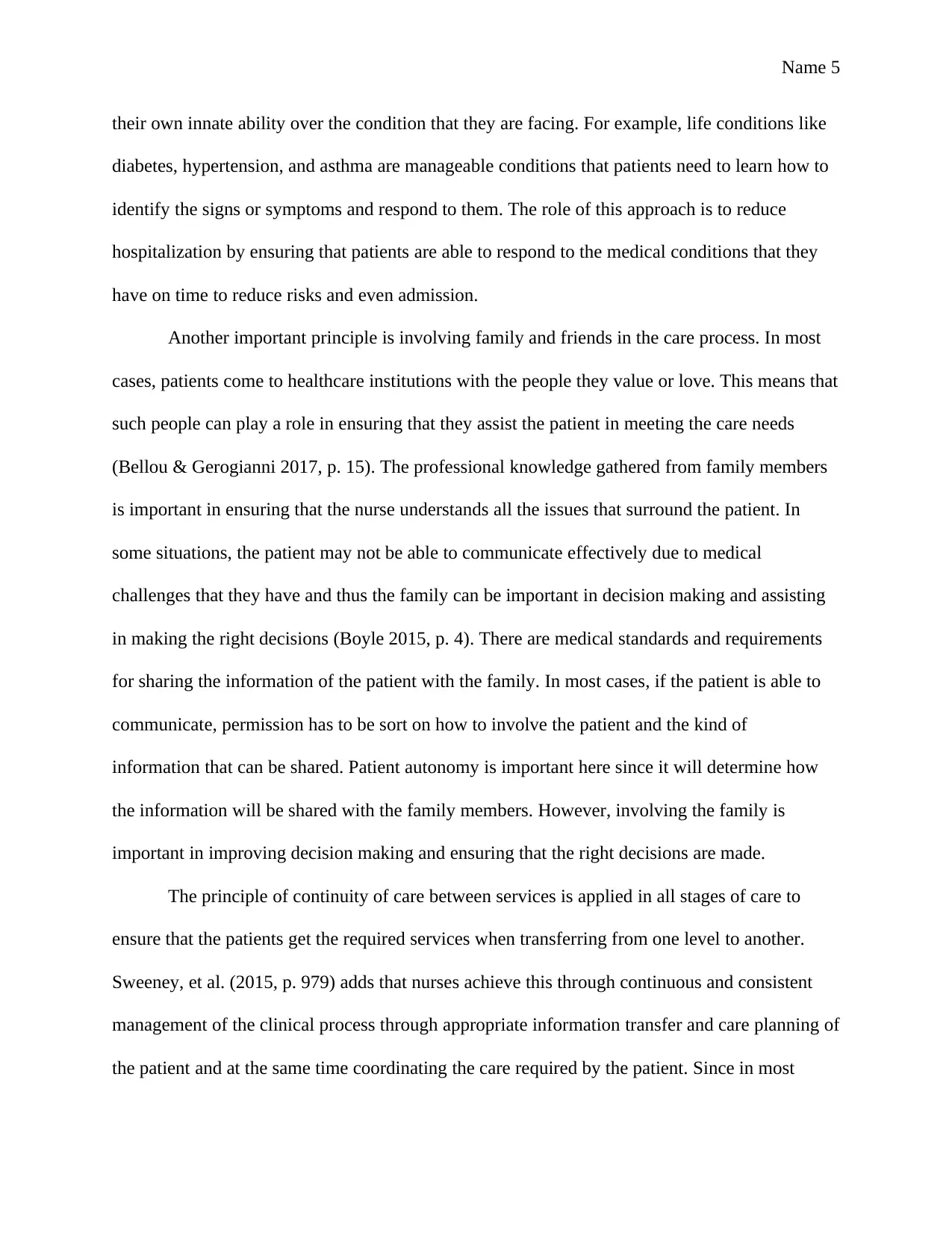
Name 5
their own innate ability over the condition that they are facing. For example, life conditions like
diabetes, hypertension, and asthma are manageable conditions that patients need to learn how to
identify the signs or symptoms and respond to them. The role of this approach is to reduce
hospitalization by ensuring that patients are able to respond to the medical conditions that they
have on time to reduce risks and even admission.
Another important principle is involving family and friends in the care process. In most
cases, patients come to healthcare institutions with the people they value or love. This means that
such people can play a role in ensuring that they assist the patient in meeting the care needs
(Bellou & Gerogianni 2017, p. 15). The professional knowledge gathered from family members
is important in ensuring that the nurse understands all the issues that surround the patient. In
some situations, the patient may not be able to communicate effectively due to medical
challenges that they have and thus the family can be important in decision making and assisting
in making the right decisions (Boyle 2015, p. 4). There are medical standards and requirements
for sharing the information of the patient with the family. In most cases, if the patient is able to
communicate, permission has to be sort on how to involve the patient and the kind of
information that can be shared. Patient autonomy is important here since it will determine how
the information will be shared with the family members. However, involving the family is
important in improving decision making and ensuring that the right decisions are made.
The principle of continuity of care between services is applied in all stages of care to
ensure that the patients get the required services when transferring from one level to another.
Sweeney, et al. (2015, p. 979) adds that nurses achieve this through continuous and consistent
management of the clinical process through appropriate information transfer and care planning of
the patient and at the same time coordinating the care required by the patient. Since in most
their own innate ability over the condition that they are facing. For example, life conditions like
diabetes, hypertension, and asthma are manageable conditions that patients need to learn how to
identify the signs or symptoms and respond to them. The role of this approach is to reduce
hospitalization by ensuring that patients are able to respond to the medical conditions that they
have on time to reduce risks and even admission.
Another important principle is involving family and friends in the care process. In most
cases, patients come to healthcare institutions with the people they value or love. This means that
such people can play a role in ensuring that they assist the patient in meeting the care needs
(Bellou & Gerogianni 2017, p. 15). The professional knowledge gathered from family members
is important in ensuring that the nurse understands all the issues that surround the patient. In
some situations, the patient may not be able to communicate effectively due to medical
challenges that they have and thus the family can be important in decision making and assisting
in making the right decisions (Boyle 2015, p. 4). There are medical standards and requirements
for sharing the information of the patient with the family. In most cases, if the patient is able to
communicate, permission has to be sort on how to involve the patient and the kind of
information that can be shared. Patient autonomy is important here since it will determine how
the information will be shared with the family members. However, involving the family is
important in improving decision making and ensuring that the right decisions are made.
The principle of continuity of care between services is applied in all stages of care to
ensure that the patients get the required services when transferring from one level to another.
Sweeney, et al. (2015, p. 979) adds that nurses achieve this through continuous and consistent
management of the clinical process through appropriate information transfer and care planning of
the patient and at the same time coordinating the care required by the patient. Since in most
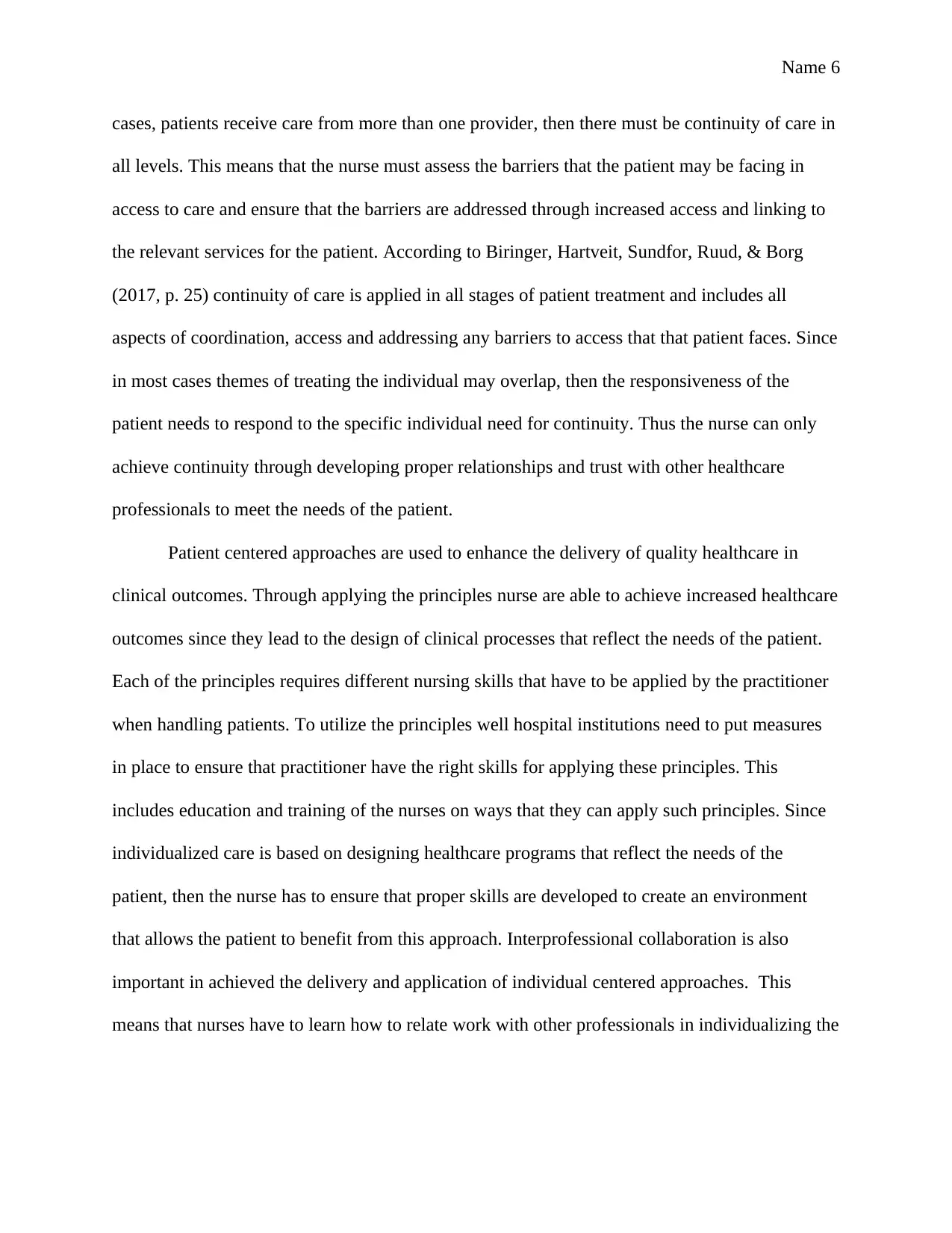
Name 6
cases, patients receive care from more than one provider, then there must be continuity of care in
all levels. This means that the nurse must assess the barriers that the patient may be facing in
access to care and ensure that the barriers are addressed through increased access and linking to
the relevant services for the patient. According to Biringer, Hartveit, Sundfor, Ruud, & Borg
(2017, p. 25) continuity of care is applied in all stages of patient treatment and includes all
aspects of coordination, access and addressing any barriers to access that that patient faces. Since
in most cases themes of treating the individual may overlap, then the responsiveness of the
patient needs to respond to the specific individual need for continuity. Thus the nurse can only
achieve continuity through developing proper relationships and trust with other healthcare
professionals to meet the needs of the patient.
Patient centered approaches are used to enhance the delivery of quality healthcare in
clinical outcomes. Through applying the principles nurse are able to achieve increased healthcare
outcomes since they lead to the design of clinical processes that reflect the needs of the patient.
Each of the principles requires different nursing skills that have to be applied by the practitioner
when handling patients. To utilize the principles well hospital institutions need to put measures
in place to ensure that practitioner have the right skills for applying these principles. This
includes education and training of the nurses on ways that they can apply such principles. Since
individualized care is based on designing healthcare programs that reflect the needs of the
patient, then the nurse has to ensure that proper skills are developed to create an environment
that allows the patient to benefit from this approach. Interprofessional collaboration is also
important in achieved the delivery and application of individual centered approaches. This
means that nurses have to learn how to relate work with other professionals in individualizing the
cases, patients receive care from more than one provider, then there must be continuity of care in
all levels. This means that the nurse must assess the barriers that the patient may be facing in
access to care and ensure that the barriers are addressed through increased access and linking to
the relevant services for the patient. According to Biringer, Hartveit, Sundfor, Ruud, & Borg
(2017, p. 25) continuity of care is applied in all stages of patient treatment and includes all
aspects of coordination, access and addressing any barriers to access that that patient faces. Since
in most cases themes of treating the individual may overlap, then the responsiveness of the
patient needs to respond to the specific individual need for continuity. Thus the nurse can only
achieve continuity through developing proper relationships and trust with other healthcare
professionals to meet the needs of the patient.
Patient centered approaches are used to enhance the delivery of quality healthcare in
clinical outcomes. Through applying the principles nurse are able to achieve increased healthcare
outcomes since they lead to the design of clinical processes that reflect the needs of the patient.
Each of the principles requires different nursing skills that have to be applied by the practitioner
when handling patients. To utilize the principles well hospital institutions need to put measures
in place to ensure that practitioner have the right skills for applying these principles. This
includes education and training of the nurses on ways that they can apply such principles. Since
individualized care is based on designing healthcare programs that reflect the needs of the
patient, then the nurse has to ensure that proper skills are developed to create an environment
that allows the patient to benefit from this approach. Interprofessional collaboration is also
important in achieved the delivery and application of individual centered approaches. This
means that nurses have to learn how to relate work with other professionals in individualizing the
⊘ This is a preview!⊘
Do you want full access?
Subscribe today to unlock all pages.

Trusted by 1+ million students worldwide

Name 7
care process. Since nurses work as intermediaries between the patient and other practitioners
they are the best professionals for applying the patient centered care approach.
care process. Since nurses work as intermediaries between the patient and other practitioners
they are the best professionals for applying the patient centered care approach.
Paraphrase This Document
Need a fresh take? Get an instant paraphrase of this document with our AI Paraphraser
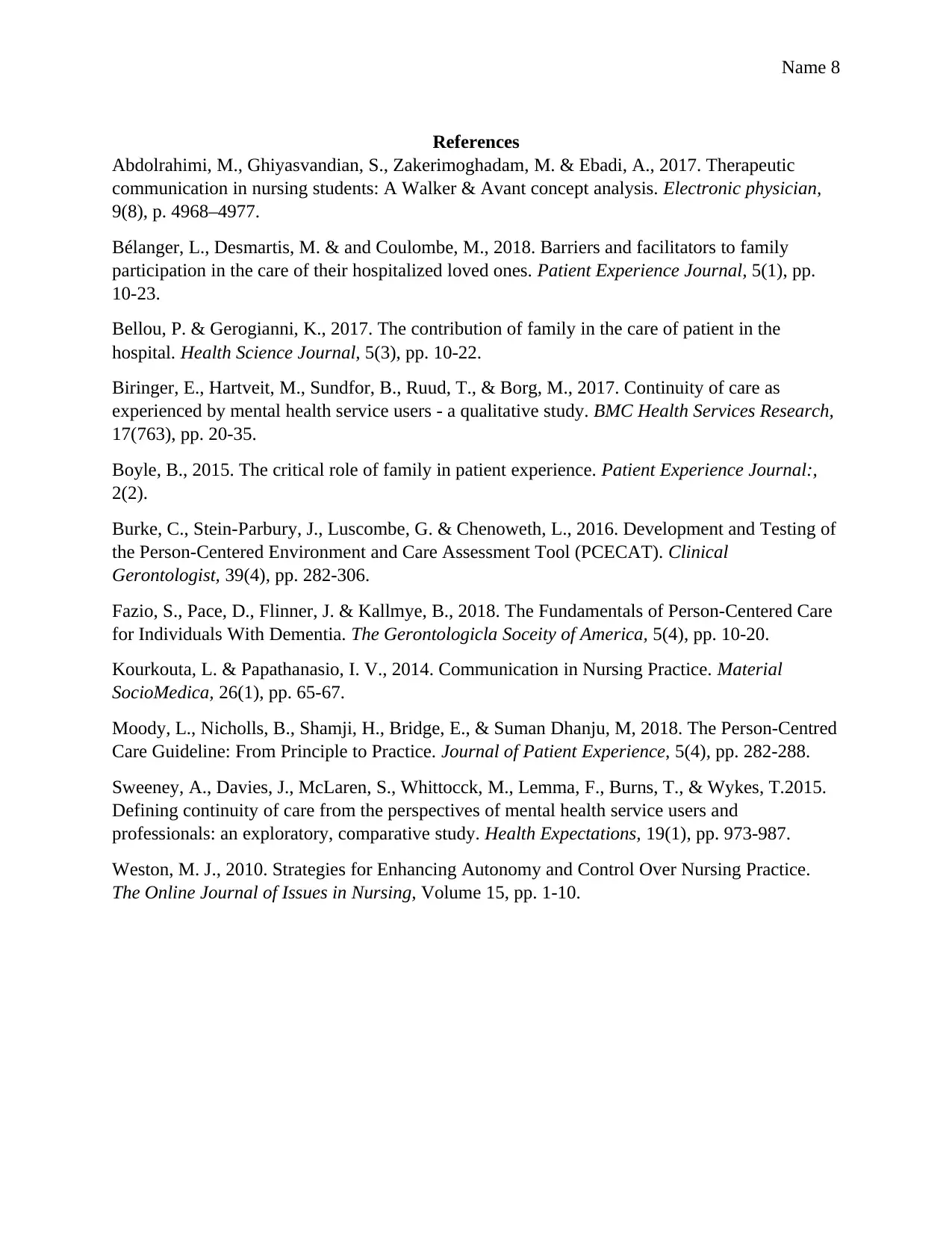
Name 8
References
Abdolrahimi, M., Ghiyasvandian, S., Zakerimoghadam, M. & Ebadi, A., 2017. Therapeutic
communication in nursing students: A Walker & Avant concept analysis. Electronic physician,
9(8), p. 4968–4977.
Bélanger, L., Desmartis, M. & and Coulombe, M., 2018. Barriers and facilitators to family
participation in the care of their hospitalized loved ones. Patient Experience Journal, 5(1), pp.
10-23.
Bellou, P. & Gerogianni, K., 2017. The contribution of family in the care of patient in the
hospital. Health Science Journal, 5(3), pp. 10-22.
Biringer, E., Hartveit, M., Sundfor, B., Ruud, T., & Borg, M., 2017. Continuity of care as
experienced by mental health service users - a qualitative study. BMC Health Services Research,
17(763), pp. 20-35.
Boyle, B., 2015. The critical role of family in patient experience. Patient Experience Journal:,
2(2).
Burke, C., Stein-Parbury, J., Luscombe, G. & Chenoweth, L., 2016. Development and Testing of
the Person-Centered Environment and Care Assessment Tool (PCECAT). Clinical
Gerontologist, 39(4), pp. 282-306.
Fazio, S., Pace, D., Flinner, J. & Kallmye, B., 2018. The Fundamentals of Person-Centered Care
for Individuals With Dementia. The Gerontologicla Soceity of America, 5(4), pp. 10-20.
Kourkouta, L. & Papathanasio, I. V., 2014. Communication in Nursing Practice. Material
SocioMedica, 26(1), pp. 65-67.
Moody, L., Nicholls, B., Shamji, H., Bridge, E., & Suman Dhanju, M, 2018. The Person-Centred
Care Guideline: From Principle to Practice. Journal of Patient Experience, 5(4), pp. 282-288.
Sweeney, A., Davies, J., McLaren, S., Whittocck, M., Lemma, F., Burns, T., & Wykes, T.2015.
Defining continuity of care from the perspectives of mental health service users and
professionals: an exploratory, comparative study. Health Expectations, 19(1), pp. 973-987.
Weston, M. J., 2010. Strategies for Enhancing Autonomy and Control Over Nursing Practice.
The Online Journal of Issues in Nursing, Volume 15, pp. 1-10.
References
Abdolrahimi, M., Ghiyasvandian, S., Zakerimoghadam, M. & Ebadi, A., 2017. Therapeutic
communication in nursing students: A Walker & Avant concept analysis. Electronic physician,
9(8), p. 4968–4977.
Bélanger, L., Desmartis, M. & and Coulombe, M., 2018. Barriers and facilitators to family
participation in the care of their hospitalized loved ones. Patient Experience Journal, 5(1), pp.
10-23.
Bellou, P. & Gerogianni, K., 2017. The contribution of family in the care of patient in the
hospital. Health Science Journal, 5(3), pp. 10-22.
Biringer, E., Hartveit, M., Sundfor, B., Ruud, T., & Borg, M., 2017. Continuity of care as
experienced by mental health service users - a qualitative study. BMC Health Services Research,
17(763), pp. 20-35.
Boyle, B., 2015. The critical role of family in patient experience. Patient Experience Journal:,
2(2).
Burke, C., Stein-Parbury, J., Luscombe, G. & Chenoweth, L., 2016. Development and Testing of
the Person-Centered Environment and Care Assessment Tool (PCECAT). Clinical
Gerontologist, 39(4), pp. 282-306.
Fazio, S., Pace, D., Flinner, J. & Kallmye, B., 2018. The Fundamentals of Person-Centered Care
for Individuals With Dementia. The Gerontologicla Soceity of America, 5(4), pp. 10-20.
Kourkouta, L. & Papathanasio, I. V., 2014. Communication in Nursing Practice. Material
SocioMedica, 26(1), pp. 65-67.
Moody, L., Nicholls, B., Shamji, H., Bridge, E., & Suman Dhanju, M, 2018. The Person-Centred
Care Guideline: From Principle to Practice. Journal of Patient Experience, 5(4), pp. 282-288.
Sweeney, A., Davies, J., McLaren, S., Whittocck, M., Lemma, F., Burns, T., & Wykes, T.2015.
Defining continuity of care from the perspectives of mental health service users and
professionals: an exploratory, comparative study. Health Expectations, 19(1), pp. 973-987.
Weston, M. J., 2010. Strategies for Enhancing Autonomy and Control Over Nursing Practice.
The Online Journal of Issues in Nursing, Volume 15, pp. 1-10.
1 out of 8
Related Documents
Your All-in-One AI-Powered Toolkit for Academic Success.
+13062052269
info@desklib.com
Available 24*7 on WhatsApp / Email
![[object Object]](/_next/static/media/star-bottom.7253800d.svg)
Unlock your academic potential
Copyright © 2020–2025 A2Z Services. All Rights Reserved. Developed and managed by ZUCOL.





